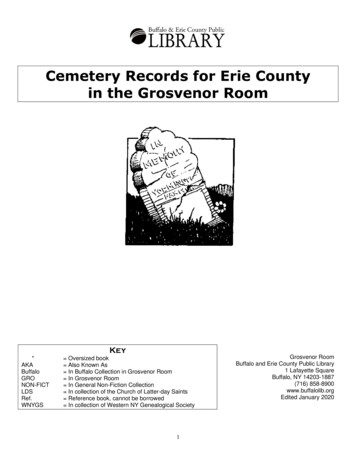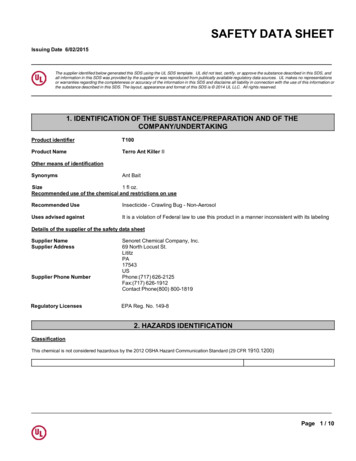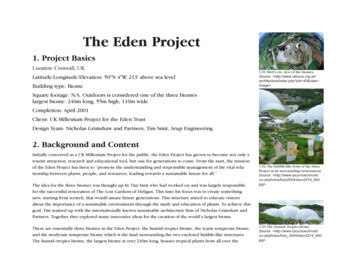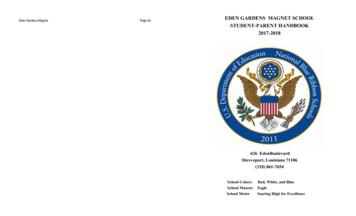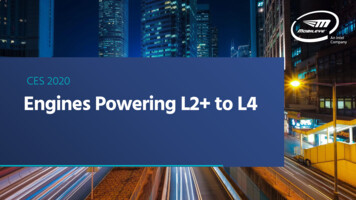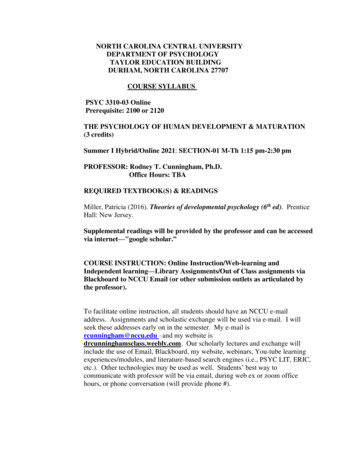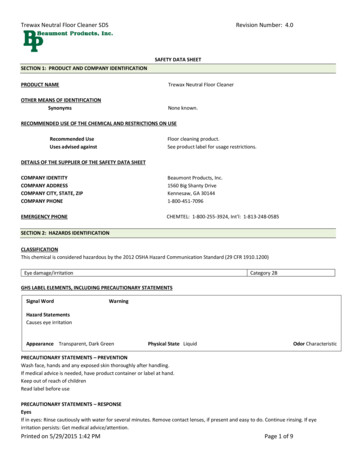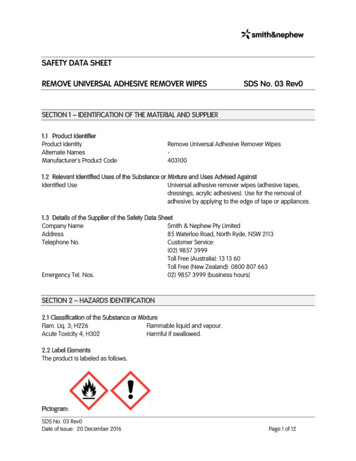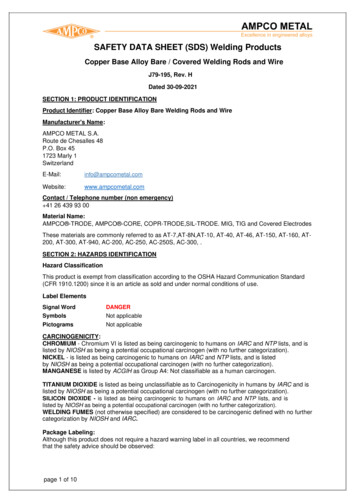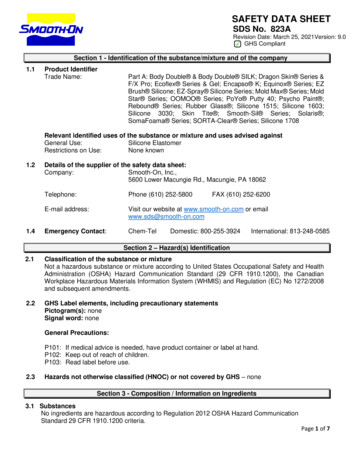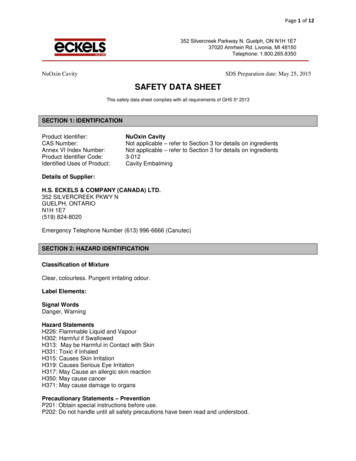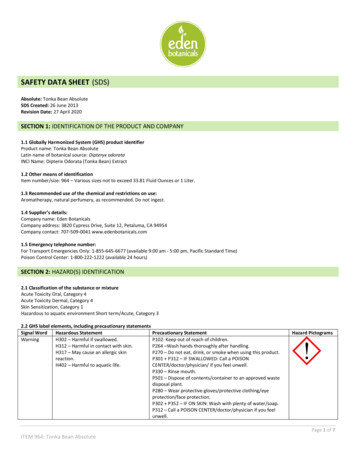
Transcription
SAFETY DATA SHEET (SDS)Absolute: Tonka Bean AbsoluteSDS Created: 26 June 2013Revision Date: 27 April 2020SECTION 1: IDENTIFICATION OF THE PRODUCT AND COMPANY1.1 Globally Harmonized System (GHS) product identifierProduct name: Tonka Bean AbsoluteLatin name of botanical source: Dipteryx odorataINCI Name: Dipterix Odorata (Tonka Bean) Extract1.2 Other means of identificationItem number/size: 964 – Various sizes not to exceed 33.81 Fluid Ounces or 1 Liter.1.3 Recommended use of the chemical and restrictions on use:Aromatherapy, natural perfumery, as recommended. Do not ingest.1.4 Supplier’s details:Company name: Eden BotanicalsCompany address: 3820 Cypress Drive, Suite 12, Petaluma, CA 94954Company contact: 707-509-0041 www.edenbotanicals.com1.5 Emergency telephone number:For Transport Emergencies Only: 1-855-645-6677 (available 9:00 am - 5:00 pm, Pacific Standard Time)Poison Control Center: 1-800-222-1222 (available 24 hours)SECTION 2: HAZARD(S) IDENTIFICATION2.1 Classification of the substance or mixtureAcute Toxicity Oral, Category 4Acute Toxicity Dermal, Category 4Skin Sensitization, Category 1Hazardous to aquatic environment Short term/Acute, Category 32.2 GHS label elements, including precautionary statementsSignal WordHazardous StatementPrecautionary StatementWarningH302 – Harmful if swallowed.P102: Keep out of reach of children.H312 – Harmful in contact with skin.P264 –Wash hands thoroughly after handling.H317 – May cause an allergic skinP270 – Do not eat, drink, or smoke when using this product.reaction.P301 P312 – IF SWALLOWED: Call a POISONH402 – Harmful to aquatic life.CENTER/doctor/physician/ if you feel unwell.P330 – Rinse mouth.P501 – Dispose of contents/container to an approved wastedisposal plant.P280 – Wear protective gloves/protective clothing/eyeprotection/face protection.P302 P352 – IF ON SKIN: Wash with plenty of water/soap.P312 – Call a POISON CENTER/doctor/physician if you feelunwell.Hazard PictogramsPage 1 of 7ITEM 964: Tonka Bean Absolute
P362 P364 – Take off contaminated clothing and wash itbefore reuse.P261 –Avoid breathing dust/fume/gas/mist/vapours/spray.P272 –Contaminated work clothing should not be allowed outof the workplace.P333 P313 –If skin irritation or rash occurs: Get medicaladvice/attention.P273 – Avoid release to the environment.2.3 Other hazards that do not result in classificationMay cause skin irritation/allergy. Patch test recommended.SECTION 3: COMPOSITION / INFORMATION ON INGREDIENTS3.1 CompositionChemical Name (common name)Tonka Bean AbsoluteEU Allergens:Benzyl AlcoholCoumarinEugenolLimoneneLinaloolCAS# TSCA8046-22-8CAS# NECS#289-793-4% by weight100 % 0.01 % 80 % 0.01 % 0.01 % 0.1 %SECTION 4: FIRST-AID MEASURES4.1 Description of necessary first-aid measures (of Substance)Eye contact:Check for and remove any contact lenses. Flush with water for 15 minutes. If symptoms persist get medical attention.Skin Contact:No harmful effect with normal skin. If skin irritation does occur, wash with water and soap and rinse thoroughly. If skin irritation continues, consulta doctor.Inhalation:Not likely to occur under normal conditions of use. If symptoms occur, move to fresh air and obtain medical advice.Ingestion:Not an expected route of exposure. In the event of swallowing, if the quantity is small (no more than one mouthful), rinse the mouth with milk orwater and consult a doctor. Keep the exposed person at rest. Do NOT force vomiting unless directed to do so by medical personnel. Seekimmediate medical attention and show the Substance’s label to medical personnel.4.2 Most important symptoms and effects, both acute and delayed (of Substance)Eye contact:May cause eye irritation and corneal damage if not immediately rinsed out.Skin Contact:Repeated contact may cause allergic dermatitis.Inhalation:Breathing high concentrations of vapor may cause anesthetic effects.Ingestion:Not an expected route of exposure.4.3 Indication of any immediate medical attention and special treatment needed (of Substance)None known.SECTION 5: FIRE-FIGHTING MEASURES5.1 Flash point 100 C5.2 Extinguishing mediaSuitable extinguishing media: sprayed water or water mist, alcohol-resistant foam, multipurpose ABC powder, BC powder, carbon dioxide (CO2)Page 2 of 7ITEM 964: Tonka Bean Absolute
Unsuitable extinguishing media: water jet (straight stream).5.3 Specific hazards arising from the chemicalNone known.5.4 Special protective actions for firefightersUse self-contained breathing apparatus and protective clothingSECTION 6: ACCIDENTAL RELEASE MEASURES6.1 Personal precautions, protective equipment and emergency proceduresStop leak if you can do so without risk. Consult safety measures listed under Sections 7 and 8.For fire-fighters:Fire-fighters will be equipped with suitable personal protective equipment (See Section 8). High temperature may increase the pressure inside thecontainer—cool the container by sprinkling water. Avoid breathing emitted vapors.6.2 Environmental precautionsContain and control the leaks or spills with non-combustible absorbent materials such as sand, earth, vermiculite, or diatomaceous earth in drumsfor waste disposal. Avoid allowing product to reach sewage system or any waterways. Inform respective authorities in case of seepage into sewagesystem or waterways.6.3 Methods and material for containment and cleaning upAbsorb spill with non-combustible matter (such as detergent--do not use solvents) and transfer to containers.SECTION 7: HANDLING AND STORAGE7.1 Precautions for safe handlingHandle in accordance with good industrial hygiene and safety practice. Avoid unintentional contact with skin surfaces. Wear suitable protectiveclothing. Avoid inhalation. Ensure good ventilation or exhaust in workplace. Do not allow contact with eyes. Always wash hands after handling.Remove and wash contaminated clothing before re-using. Ensure that there is adequate ventilation, especially in confined areas.7.2 Conditions for safe storage, including any incompatibilitiesStore in closed glass containers, away from heat, light and other sources of ignition. Store in cool area.SECTION 8: EXPOSURE CONTROL / PERSONAL PROTECTION8.1 Control parametersOSHA TWA: None establishedOSHA STEL: None establishedACGIH TWA: None establishedACGIH STEL: None establishedNOHSC TWA: None establishedNOHSC STEL: None established8.2 Appropriate engineering controlsGeneral room or local exhaust ventilation is usually required to meet exposure limit(s). Electrical equipment should be grounded and conform toapplicable electrical code.8.3 Individual protection measuresPersonal protective equipment:Use personal protective equipment that is clean and has been properly maintained. Store personal protective equipment in a clean place awayfrom the work area. Never eat, drink, or smoke during use. Remove and wash contaminated clothing before re-using.Eye/face protection:Avoid contact with eyes. Use eye protectors (safety goggles in accordance with standard EN166) designed to protect against liquid splashes.Hand protection:Wear suitable protective gloves (resistant to chemical agents in accordance with standard EN374) in the event of prolonged or repeated skincontact.Type of gloves recommended: Nitrile rubber (butadiene-acrylonitrile copolymer rubber (NBR)) or PVA (Polyvinyl alcohol).Page 3 of 7ITEM 964: Tonka Bean Absolute
Body protection: Work clothing worn by personnel shall be laundered regularly. After contact with the product, all parts of the body that havebeen soiled must be washed.SECTION 9: PHYSICAL CHEMICAL PROPERTIESPhysical state: Viscous, solid at room temperatureColor: Light brownOdor: Very rich, caramel-like, powdery-sweet aroma of new mown hay with a warm herbal and soft tobacco-like undertone; very tenacious.Miscibility in water: InsolubleMiscibility in alcohol: InsolubleMiscibility in essential oil: SolubleLiposolubility: LiposolublepH: Not applicableBoiling point/boiling range: Not specifiedFlash Point: 100 CVapor pressure: Not specifiedEvaporation rate: Not specifiedDensity: Not specifiedWater solubility: InsolubleSelf-ignition temperature: Not specifiedDecomposition point/decomposition range: Not specifiedRefractive index @ 20 C: Not specifiedPartition coefficient: Not specifiedSpecific gravity @ 20 C: Not specifiedSECTION 10: STABILITY AND REACTIVITY10.1 ReactivityNot reactive.10.2 Chemical stabilityThis substance is stable under the recommended handling and storage conditions in Section 7.10.3 Possibility of hazardous reactionsWhen exposed to high temperatures, the substance may release hazardous decomposition products, such as carbon monoxide, carbon dioxide,fumes, and nitrogen oxide.10.4. Conditions to avoidHeat, open flame, sunlight.10.5 Incompatible materialsAlkali metals, ammonia, oxidizing agents, peroxides strong inorganic acids.10.6 Hazardous decomposition productsNone – when carefully used.SECTION 11: TOXICOLOGICAL INFORMATION11.1 SubstanceAcute toxicity:Effect by ingestion: LD50 for rat 1380 mg/kgEffect by skin contact: LD50 for rabbit 1260 mg/kgSkin corrosion/irritation:May be irritating to skin.Page 4 of 7ITEM 964: Tonka Bean Absolute
Serious eye damage/irritation:May be irritating to eyes. Prompt rinsing and removal of the substance will avoid damage.Respiratory sensitization:Breathing high concentrations of vapor may cause anesthetic effects.Germ cell mutagenicity:Not specifiedCarcinogenicity:IARH: No component of this product present at levels greater than or equal to 0.1% is identified asprobable, possible or confirmed human carcinogen by IARC.ACGIH: No component of this product present at levels greater than or equal to 0.1% is identified asprobable, possible or confirmed human carcinogen by IARC.NTP: No component of this product present at levels greater than or equal to 0.1% is identified asprobable, possible or confirmed human carcinogen by IARC.OSHA: No component of this product present at levels greater than or equal to 0.1% is identified asprobable, possible or confirmed human carcinogen by IARC.Reproductive toxicity:Not specifiedSTOT-single exposure:Not specifiedSTOT-related exposure:Not specifiedAspiration hazard:Not specified11.2 Information on the likely routes of exposureSkin/scalp contact.11.3 Symptoms related to the physical, chemical, and toxicological characteristicsNone known. Irritation of the eye if exposed. Redness of the skin if irritated.11.4 Delayed and immediate effects and also chronic effects from short-term and long-term exposureExposure to vapors from this solvent in excess of the stated occupational exposure limit may result in adverse health effects such as mucousmembrane and respiratory system irritation and adverse effects on kidney, liver, and central nervous system.Repeated or prolonged contact with the substance may cause removal of natural oil from the skin, resulting in non-allergic contact dermatitisand absorption through the skin. Splashes in the eyes may cause irritation and reversible damage.11.6 Interactive effectsNot specified11.7 Where specific chemical data are not availableNot specified11.8 SubstancesNot specified11.9 Substances verses ingredient informationNot specified11.10 Other InformationNoneSECTION 12: ECOLOGICAL INFORMATION12.1 Info summery of Ecological informationBalance of data on substance as a whole, not determined.12.2 Eco toxicological properties of specific substancesSee each category below for specific substances12.3 ToxicityAcute fish toxicity:LC50 / 96 HOUR – No data availablePage 5 of 7ITEM 964: Tonka Bean Absolute
Toxicity to aquatic plants – No data availableToxicity to microorganisms – No data availableToxicity threshold – No data available12.4 Persistence and degradabilityBiodegradation is expected12.5 Bio-accumulative potentialBioaccumulation is unlikely12.6 Mobility in soilUnknown12.7 Other adverse effectAvoid exposure to marine environments and waterwaysSECTION 13: DISPOSAL CONSIDERATIONS13.1 Waste treatment methodsDo not pour into drains or waterways. Observe all federal, state, and local environmental regulations. Member State-specific and Communityspecific provisions must be considered. Considering the relevant known environmental and human health hazards of the materials, review andimplement appropriate technical and procedural wastewater and waste disposal measures to prevent occupational exposure and environmentalrelease. It is recommended that waste minimization be practiced. The best available technology should be utilized to prevent environmentalrelease. This may include destructive techniques for waste and wastewater. In extreme situations, contact a licensed professional waste disposalservice to dispose of this material.Waste:Proper waste management of the substance and/or its container must be determined in accordance with Directive 2008/98/EC. Do not pour intodrains or waterways. Waste management is carried out without endangering human health, without harming the environment, and in particularwithout risk to water, air, soil, plants, or animals. Recycle or dispose of waste in compliance with current legislation, preferably via a certifiedcollector or company.Soiled packaging:Empty all containers completely. Keep label(s) on every container. Give to a certified disposal contractor.SECTION 14: TRANSPORT INFORMATION14.1 UN NumberNot regulated14.2 UN Proper shipping nameNot regulated14.3 Transportation hazard classesRoad (U.S. DOT): Not regulatedAir (IATA): Not regulatedSea (IMDG): Not regulated14.4 Packing group, if applicableNot specified14.5 Environmental hazardsHarmful to aquatic life. Avoid exposure to waterways.14.6 Special precautions for userNot specified14.7 Transport in bulk according to Annex II of MARPOL 73/78 and IBC CodeNot specifiedPage 6 of 7ITEM 964: Tonka Bean Absolute
14.8 Additional transport informationNot specifiedSECTION 15: REGULATORY INFORMATION15.1 Safety, health, and environmental regulations/legislation specific for the substanceCountryNotificationCanadaNot regulatedEUSee EU Allergens in Section 3Hong KongNot regulatedSingaporeNot regulatedUSANot regulated by Federal or State RegulationsCalifornia Prop. 65 ComponentsThis product does not contain any chemicals known to the State of California to cause cancer, birth defects, orreproductive harm.SECTION 16: OTHER INFORMATIONDisclaimer:The information in this Safety Data Sheet (SDS) is believed to be accurate as of the date issued. HOWEVER, NO WARRANTY, EXPRESSED ORIMPLIED IS MADE CONCERNING THE ACCURACY, COMPLETENESS OR RELIABILITY OF THE INFORMATION PROVIDED HEREIN, INCLUDING BUT NOTLIMITED TO, WARRANTY OF MERCHANTABILITY OR FITNESS FOR ANY PARTICULAR PURPOSE OR COURSE OF PERFORMANCE. The informationprovided relates only to the specified product designated and may not be applicable where such product is used in combination with any othermaterials or in any process. Since the conditions and methods of handling, storage, use and disposal of the product are beyond the control ofIntelligent Nutrients, Intelligent Nutrients expressly disclaims any and all liability, loss or damage arising out of or relating to the use, storage,handling or disposal of the product or reliance on the information in this SDS. Users are cautioned to satisfy themselves as to the suitability of saidinformation, procedures and recommendations for the purposes intended prior to use.RevisionR.1R.2R.3R.4Date21 March 2016October 4 2016October 3 2017April 27 2020Prepared ByL. BonaventuraMEBBMEBBL. BonaventuraReviewed ByPage 7 of 7ITEM 964: Tonka Bean Absolute
ITEM 964: Tonka Bean Absolute SAFETY DATA SHEET (SDS) Absolute: Tonka Bean Absolute SDS Created: 26 June 2013 Revision Date: 27 April 2020 SECTION 1: IDENTIFICATION OF THE PRODUCT AND COMPANY 1.1 Globally Harmonized System (GHS) product identifier Product name: Tonka Bean Absolute Latin name of botanical source: Dipteryx odorata
